

Understanding the Business. Boxes and Arrows is delighted to share this excerpt from Kim Goodwin’s excellent Designing for the Digital Age.

When I recently taught a class on user experience design, I found few good resources on gathering business requirements. I was so happy when I cracked open Kim’s book and found exactly what my students needed. And thanks to her generosity, and Wiley’s, we are able to reprint the chapter in its entirety. ~Christina Wodtke, January 2013 While we designers like to think of ourselves as advocating for end users, we’re ultimately responsible for helping our customers: the employers or clients who hire us to help achieve certain organizational goals.
Why is the project important? Understanding the business starts with stakeholder interviews. You may also need to include someone from corporate marketing to discuss brand ideals and interpretation of the identity in the product. A Stakeholder Interview Checklist. This is an excerpt from from Kim Goodwin’s excellent Designing for the Digital Age.
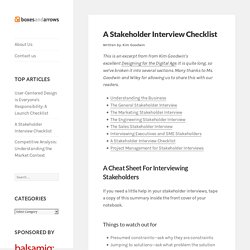
It is quite long, so we’ve broken it into several sections. Many thanks to Ms. Goodwin and Wiley for allowing us to share this with our readers. A Cheat Sheet For Interviewing Stakeholders If you need a little help in your stakeholder interviews, tape a copy of this summary inside the front cover of your notebook. Things to watch out for Presumed constraints—ask why they are constraintsJumping to solutions—ask what problem the solution would solve All stakeholders What is your role in this project? Marketing stakeholders Who are your customers and users today, and how do you want that to be different in five years? Engineering stakeholders What technology decisions have already been made, and how firm are they?
Sales stakeholders Who is typically involved in the purchase decision? Senior executives Subject matter experts Other product team members QA: What problems do you currently see in development? Project Management for Stakeholder Interviews. This is an excerpt from from Kim Goodwin’s excellent Designing for the Digital Age .
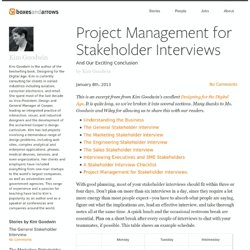
It is quite long, so we’ve broken it into several sections. Many thanks to Ms. Goodwin and Wiley for allowing us to share this with our readers. With good planning, most of your stakeholder interviews should fit within three or four days. Don’t plan on more than six interviews in a day, since they require a lot more energy than most people expect—you have to absorb what people are saying, figure out what the implications are, lead an effective interview, and take thorough notes all at the same time. Try for at least a couple of the most critical stakeholders near the beginning of your schedule. When You Can’t Interview Stakeholders The approach outlined above works well when you have an officially sanctioned project with support from the management team.
Summary Goal-Directed design isn’t just about accomplishing user goals; a product or service that doesn’t also accomplish a business goal is a failure. The Marketing Stakeholder Interview. This is an excerpt from from Kim Goodwin’s excellent Designing for the Digital Age .
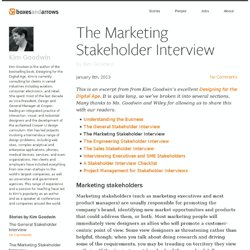
It is quite long, so we’ve broken it into several sections. Many thanks to Ms. Goodwin and Wiley for allowing us to share this with our readers. Marketing stakeholders (such as marketing executives and most product managers) are usually responsible for promoting the company’s brand, identifying new market opportunities and products that could address them, or both. Most marketing people will immediately view designers as allies who will promote a customer-centric point of view.
There are a number of questions the marketing people are best equipped to answer; some examples follow. Who are your customers and users today, and how do you want that to be different in five years? It’s essential to see where the marketing team wants to take the product or the brand, especially if it involves a change in direction. Sometimes the vision is so ambitious that it sounds impossible. The General Stakeholder Interview.
This is an excerpt from from Kim Goodwin’s excellent Designing for the Digital Age .
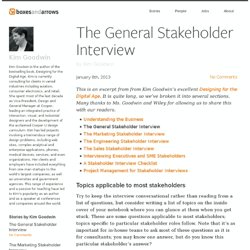
It is quite long, so we’ve broken it into several sections. Many thanks to Ms. Goodwin and Wiley for allowing us to share this with our readers. Try to keep the interview conversational rather than reading from a list of questions, but consider writing a list of topics on the inside cover of your notebook where you can glance at them when you get stuck. The Sales Stakeholder Interview. This is an excerpt from from Kim Goodwin’s excellent Designing for the Digital Age .
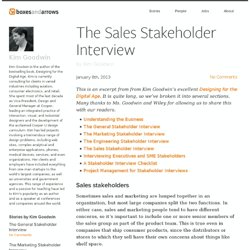
It is quite long, so we’ve broken it into several sections. Many thanks to Ms. Goodwin and Wiley for allowing us to share this with our readers. Sometimes sales and marketing are lumped together in an organization, but most large companies split the two functions. In either case, sales and marketing people tend to have different concerns, so it’s important to include one or more senior members of the sales group as part of the product team. An enterprise system sales team is often closer to the customers than the marketing team is. A sales person’s biggest worry during design research is that there will be other people spending time with his customers, possibly making a bad impression, promising things he can’t deliver, or saying something that will cause the customer to wait and buy next year’s version instead of next month’s incremental upgrade. Who is typically involved in the purchase decision?
The Engineering Stakeholder Interview. This is an excerpt from from Kim Goodwin’s excellent Designing for the Digital Age . It is quite long, so we’ve broken it into several sections. Many thanks to Ms. Goodwin and Wiley for allowing us to share this with our readers. Try to speak with engineering management as well as the design engineer(s), if such a role exists; it’s seldom a good idea to involve the entire engineering team at this point.
If there are no design engineers, a system architect and GUI lead may be the best option for software expertise. Programmers and engineers may initially be wary of designers. The focus and length of engineering interviews differs quite a bit between a new product and a revision of an existing one; in the first case, there is more room for the design to drive the technology, while in the second, the capabilities of the existing technology, when combined with the project budget and timeline, may introduce significant design limitations. Interviewing Executives and SME Stakeholders.